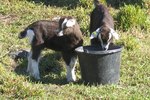
Dwarf hamsters can reproduce rapidly. Just one pair of mating-age dwarf hamsters can produce six to 12 new hamsters every month. You will need to modify your hamster-keeping practices in order to prevent unwanted pups. Your female hamster may be pregnant if she seems to have gained a lot of weight in just a couple of days, if you notice she's unusually active or if you witness her spending a lot of effort building her nest up.
If You Catch Them in the Act
Catching your dwarf hamsters in the act of mating is the easiest way to confirm your suspicions. If one hamster is standing on his hind legs behind the female hamster and mounting her while moving back and forth you can be fairly certain they are mating. Interrupting them in the act will probably not stop the inevitable unless you already have another cage ready and waiting so that you can separate them.
If You Have a Litter
More than a handful of new hamster owners have been surprised to look in their hamster's cage and discover two hamsters have turned into 10. If your hamsters have reproduced, you need to remove the male from the cage immediately. Dwarf females come back into heat immediately after giving birth -- and it is unhealthy for your female hamster to have two pregnancies back to back. If you are unsure which of your hamsters is the female, she will be in the one in the nest nursing the pups. Female hamsters do not need your help to raise their pups and will sometimes reject a pup that has been touched by a human so it is best to leave the new family alone once you have removed the male to another cage. Make sure to provide the new mother with plenty of food, water and bedding. An extra teaspoon of food each day may be appreciated by the nursing mother.
Determine Your Hamsters' Genders
To prevent further unwanted litters, you need to separate your hamsters by gender before they can breed. If you have had a litter, an experienced veterinarian should be able to identify the genders of the offspring at approximately 5 weeks of age. Juvenile dwarf hamsters can breed when they are less than three months old, so it is best to separate the genders as quickly as possible if you want to avoid having another litter. Determine the gender of your hamsters by turning them over and examining their genitalia. Dwarf hamsters are often difficult to sex because their genitals are close together and difficult to see. The anus and the penis will be further apart on a male, the two openings on a female will be very close together.
Separating Your Hamsters
Now that you know your hamsters are mating you need to take preventative measures to avoid producing more hamsters than you can care for and to discourage inbreeding. Separate your hamsters into different cages by gender to avoid unplanned reproduction. Do not put more than two hamsters in each cage, as dwarf hamsters can become aggressive toward the less dominant members of a group. Avoid introducing males to females unless you intend to breed the pair.
References
Photo Credits
-
Hamster image by Stana from Fotolia.com
Writer Bio
Jen Davis has been writing since 2004. She has served as a newspaper reporter and her freelance articles have appeared in magazines such as "Horses Incorporated," "The Paisley Pony" and "Alabama Living." Davis earned her Bachelor of Arts in communication with a concentration in journalism from Berry College in Rome, Ga.




